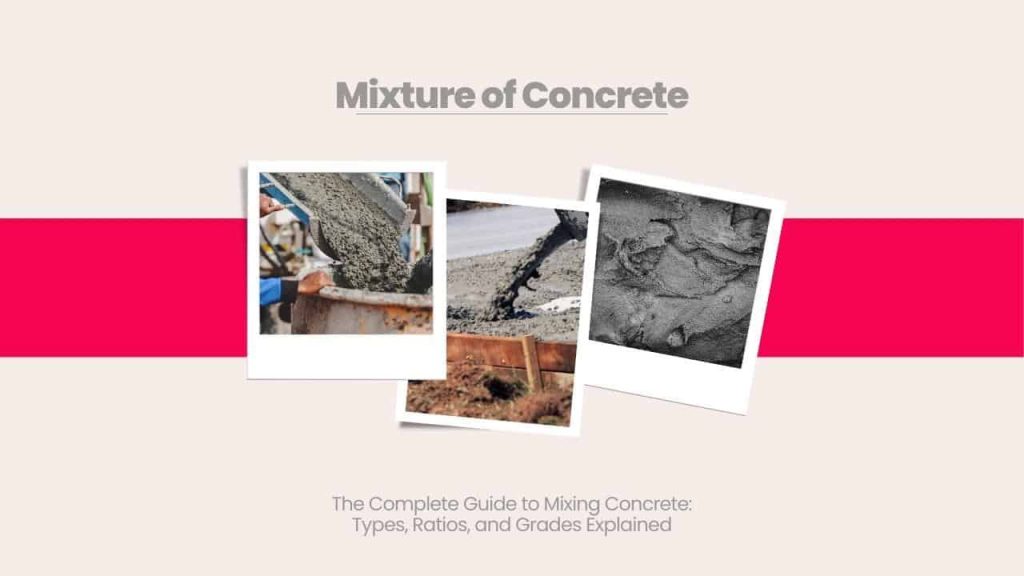
Concrete, a fundamental building material, finds use in various construction projects due to its strength, durability, and versatility. It is a blend of cement, water, and aggregates. Though the ingredients are simple, the process of mixing them to create concrete can be complicated. Several factors impact the quality of the mixture of concrete, such as the type of cement and aggregates used, the ratio of the ingredients, and the mixing method. This article explores the different methods of mixing concrete, their advantages, and their disadvantages. Whether you’re a professional contractor or a DIY enthusiast, understanding these methods can help you create the perfect concrete mix for your next project.
What is Concrete?
Concrete is a versatile building material that is commonly used in construction. It is made by mixing cement, water, and aggregates such as sand, gravel, or crushed stone. The mixture is then poured into a mold and allowed to harden and cure over time. Concrete is known for its strength, durability, and ability to withstand a variety of environmental conditions. It is also relatively easy to work with and can be molded into different shapes and sizes. Because of these properties, concrete is a popular choice for building foundations, walls, floors, bridges, and other structures.
Why Mixing is Important?
Mixing of concrete determines the quality, strength, and durability of the final product, making it a critical step in the construction process. The process of mixing uniformly distributes cement, water, and aggregates, resulting in a consistent mixture capable of withstanding the forces of nature and the weight of the structure.
Weak points, cracks, and other defects that can compromise the structural integrity of the building may arise from poorly mixed concrete. The mixing process can also affect the setting time and workability of the concrete, which can impact the ease of placement and finishing. Therefore, proper mixing of concrete is essential to ensure a safe, reliable, and long-lasting structure.
Ideal Mixture OR Ratio of Concrete
The ideal mixture and ratio of concrete depend on the intended use of the concrete. Generally, the mix ratio for concrete is 1:2:3, which means one part cement, two parts sand, and three parts gravel or stone. This ratio produces a standard concrete mix that is suitable for most construction projects. However, for more specialized projects, the mix ratio may vary.
For example, a mix of 1:1.5:3 may be used for reinforced concrete, while a mix of 1:2:4 may be used for structural concrete. Additionally, the water-to-cement ratio is an important factor in determining the strength and durability of the concrete. The ideal water-to-cement ratio is typically around 0.5 to 0.6, which means that for every kilogram of cement, 0.5 to 0.6 kilograms of water should be used. It is important to carefully measure and mix the ingredients to achieve the desired strength, consistency, and durability of the concrete.
Methods of Mixing Concrete
There are several methods of mixing concrete, each with its advantages and disadvantages. Here are some of the most common methods:
Hand Mixing
Mixing the ingredients manually using a shovel or hoe is the method involved in hand-mixing concrete. It is ideal for small projects where only a small amount of concrete is needed. Hand-mixing concrete works best for small projects such as repairing cracks in walls or building small structures like garden walls or sheds. It is also useful in locations where access to power or machinery is limited. However, hand mixing is not recommended for large projects as it is labor-intensive and can result in inconsistencies in the mix.
Proper measurement and proportioning of the ingredients are crucial in hand mixing to ensure the strength and durability of the concrete. Therefore, following the correct mixing procedures and ratios as specified by the manufacturer or engineer is essential to achieve the desired results.
Machine Mixing
The machine mixing process of concrete utilizes a machine, such as a concrete mixer, to mix the ingredients, making it ideal for large projects requiring significant amounts of concrete. The machine can be either a stationary or mobile device, powered by electricity or fuel.
To begin the process, the mixer loads the cement, water, and aggregates in the correct proportions as specified by the engineer or manufacturer. The mixer then rotates the contents at a predetermined speed and direction, ensuring the ingredients are evenly mixed to create a uniform and consistent mixture.
Compared to hand mixing, the machine mixing process provides several advantages such as greater efficiency, consistency, and speed. It also minimizes labor requirements for mixing, and the mixing process is precisely controlled to provide a high-quality mix. The mixer can also be adjusted to attain the desired mix consistency, and adjustments can be made during the process as needed.
In conclusion, the machine mixing process of concrete provides an efficient and consistent method of mixing for large projects, ensuring high quality and strength of the final product.
Precautionary Steps for Mixing Concrete
- Wear appropriate personal protective equipment (PPE): Before beginning the mixing process, it is important to wear PPE, such as safety glasses, gloves, and a dust mask, to protect yourself from potential hazards.
- Properly measure ingredients: It is crucial to accurately measure the ingredients to achieve the desired strength and consistency of the concrete. Using a scale or measuring cups can help ensure the correct ratios are used.
- Use clean equipment: Before beginning the mixing process, it is important to clean all tools and equipment to prevent any contaminants from affecting the strength and consistency of the concrete.
- Mix dry ingredients first: To achieve a consistent mixture, it is recommended to mix the dry ingredients (such as cement, sand, and aggregate) first before adding water.
- Gradually add water: Adding too much water can weaken the concrete, so it is important to add water gradually while monitoring the consistency of the mixture. The ideal water-to-cement ratio should be around 0.5 to 0.6.
- Mix thoroughly: To ensure a consistent mixture, it is important to mix the ingredients thoroughly for at least 5-10 minutes using a concrete mixer or by hand.
- Avoid over-mixing: Over-mixing can cause the concrete to become weak and crumbly, so it is important to stop mixing once the desired consistency has been achieved.
- Use the concrete promptly: Once the concrete has been mixed, it should be used promptly to prevent it from hardening and becoming unusable.
- Clean up properly: After the mixing process is complete, it is important to properly clean all tools and equipment to prevent any residue from affecting future batches of concrete.
Conclusion
In conclusion, there are several methods for mixing concrete, and each has its advantages and disadvantages. The choice of method depends on various factors such as the project size, required strength, and available resources. Hand mixing is suitable for small projects and produces good-quality concrete but is time-consuming. On the other hand, machine mixing is faster and produces more consistent concrete, making it ideal for large-scale projects. Ready-mix concrete is a convenient option that eliminates the need for on-site mixing but is more expensive. It is crucial to follow the proper safety guidelines and mix design specifications when mixing concrete to ensure optimal strength and durability. Ultimately, selecting the appropriate method of mixing concrete can save time, money, and resources while ensuring a quality finished product.
Try Onsite, #1 Tool For Site Tracking
People also search for: concrete ratios, cement types and grades, concrete ingredients, what type of mixture is concrete, hand mixing concrete ratio, how to mix concrete manually,







